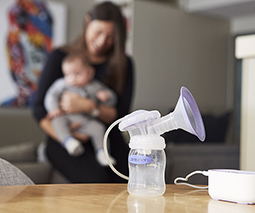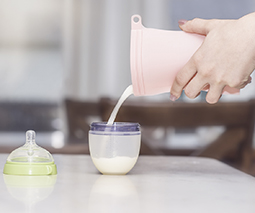Let it flow: The low-down on your breastfeeding let-down

Everyone knows what breastfeeding is but few talk about the amazing process involved called the “let-down”. So what is it exactly? And how does it work? Here’s a little let-down low-down for you. You’re welcome!
What is the let-down?
The let-down is the milk ejection reflex in breastfeeding mothers which allows milk to flow through the breast – and to the baby.
When your baby sucks at your breast (or the nerves in your nipple are otherwise triggered), the hormones prolactin and oxytocin are released. They respectively help produce the milk and push it through the breast, to then be “let down” through your nipple.
What it feels like
Most women describe it as a tingly sensation in the nipples with the breasts feeling very full and firm, however some mums feel nothing and don’t notice any changes whatsoever. There’s no apparent reason behind these differences, but if your breasts are particularly full it’s likely that the let-down will feel more intense.
Some women start leaking (or even spraying!) milk from their breasts during a let-down. This is when babies usually switch from short, shallow sucks to strong, longer ones.
In some cases – shortly after birth – women may also feel their uterus contracting during a let-down which can be quite painful. This usually passes after a few weeks though.

When it happens
A let-down generally occurs as a response to your baby sucking at your breast and happens two or three times during a feed, whether you feel it or not. It can however also occur at other times such as:
- When expressing milk via a breast pump or your hand
- Thinking about, hearing or seeing your baby – including just a picture of them
- Hearing your baby, or any other baby, cry
- When you touch your nipples
- Your breasts being stimulated by your partner
- Warm water from the shower
Read more about breastfeeding issues:
- D-MER: The chemical reaction to breastfeeding that could be making you feel sad
- 15 common breastfeeding problems and how to solve them
- I accidentally starved my baby while breastfeeding and you need to read how
How to encourage your “let-down”
For women not experiencing any issues breastfeeding, the let-down is something that will happen automatically and you won’t have to worry about, but factors like tiredness, pain and stress can affect the let-down.
For those who find breastfeeding more challenging, establishing a good let-down is important for ensuring efficient feeds. Mums who are expressing milk regularly may need to pay more attention to their let-down for best results too.
Here are some tips for helping create a good let-down:
- Make sure your baby is correctly attached to the breast
- Be comfortable when feeding or expressing
- Think about and look at your baby (or a picture if using a breast pump)
- Relax as much as possible
- Massage your breast or hand express before starting a feed
Let-down management
Because a let-down can happen unexpectedly when you might be away from your baby or out and about (such as hearing someone else’s bub cry in the middle of the supermarket), it’s important to be prepared – especially if you’re one of those breastfeeding mums who’s prone to jet propulsion sprays!
In the early months, before you and your baby establish a solid breastfeeding routine, it’s a good idea to wear breast pads in your bra to prevent embarrassing leaks through your clothes. When you might be starting to wean is another good time for this when your breasts are a little out of whack and unpredictable.
Additionally, as the first let-down can come on pretty strong for some, it’s also important to be mindful of this for the sake of your baby who might struggle with the fast milk flow. It may worsen conditions for babies with reflux, make them upset or in some cases even choke. Simple ways to manage this however are to express slightly before a feed, be in a reclined position so your milk doesn’t flow directly down toward their throat, and be sure to burp your baby frequently.
If you’re having trouble with breastfeeding be sure to speak to your doctor or a lactation consultant. There is help at hand.














